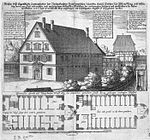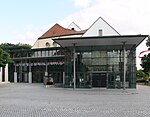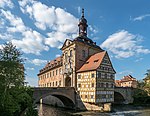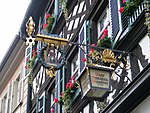Bamberg station
1844 establishments in BavariaBuildings and structures in BambergNuremberg S-Bahn stationsRailway stations in BavariaRailway stations in Germany opened in 1844

Bamberg station is the only passenger station of the city of Bamberg in Upper Franconia in the German state of Bavaria. It is a major hub station for local trains operated by Deutsche Bahn and Agilis and is also a regularly served by Intercity-Express and Intercity trains. The station is on the Nuremberg–Bamberg, Bamberg–Hof and Bamberg–Rottendorf railway lines. It has seven platform tracks and is classified by Deutsche Bahn as a category 2 station. It is the northern terminus of line S1 of the Nuremberg S-Bahn.
Excerpt from the Wikipedia article Bamberg station (License: CC BY-SA 3.0, Authors, Images).Bamberg station
Ludwigstraße,
Geographical coordinates (GPS) Address Nearby Places Show on map
Geographical coordinates (GPS)
| Latitude | Longitude |
|---|---|
| N 49.900833333333 ° | E 10.899444444444 ° |
Address
Bamberg
Ludwigstraße
96052 , Gärtnerstadt
Bavaria, Germany
Open on Google Maps









